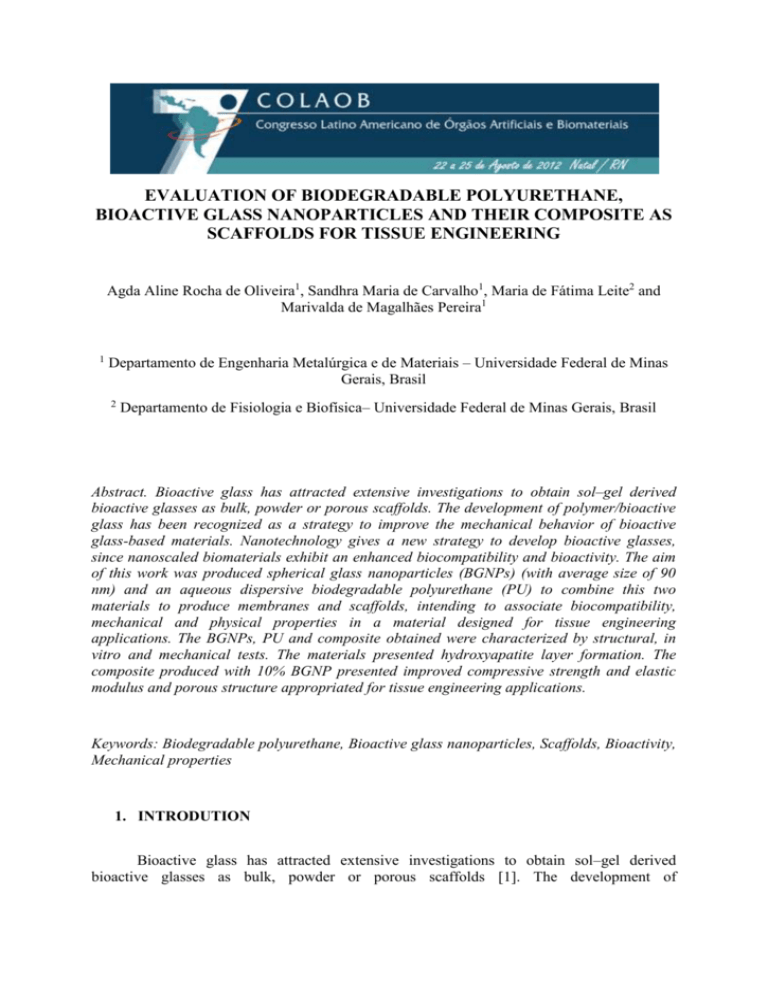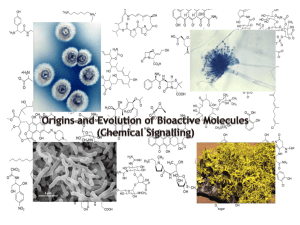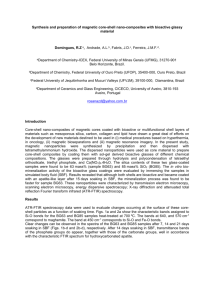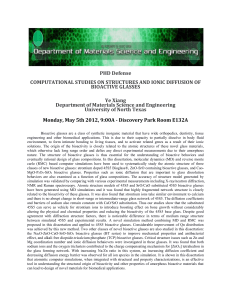evaluation of biodegradable polyurethane, bioactive
advertisement

EVALUATION OF BIODEGRADABLE POLYURETHANE, BIOACTIVE GLASS NANOPARTICLES AND THEIR COMPOSITE AS SCAFFOLDS FOR TISSUE ENGINEERING Agda Aline Rocha de Oliveira1, Sandhra Maria de Carvalho1, Maria de Fátima Leite2 and Marivalda de Magalhães Pereira1 1 Departamento de Engenharia Metalúrgica e de Materiais – Universidade Federal de Minas Gerais, Brasil 2 Departamento de Fisiologia e Biofísica– Universidade Federal de Minas Gerais, Brasil Abstract. Bioactive glass has attracted extensive investigations to obtain sol–gel derived bioactive glasses as bulk, powder or porous scaffolds. The development of polymer/bioactive glass has been recognized as a strategy to improve the mechanical behavior of bioactive glass-based materials. Nanotechnology gives a new strategy to develop bioactive glasses, since nanoscaled biomaterials exhibit an enhanced biocompatibility and bioactivity. The aim of this work was produced spherical glass nanoparticles (BGNPs) (with average size of 90 nm) and an aqueous dispersive biodegradable polyurethane (PU) to combine this two materials to produce membranes and scaffolds, intending to associate biocompatibility, mechanical and physical properties in a material designed for tissue engineering applications. The BGNPs, PU and composite obtained were characterized by structural, in vitro and mechanical tests. The materials presented hydroxyapatite layer formation. The composite produced with 10% BGNP presented improved compressive strength and elastic modulus and porous structure appropriated for tissue engineering applications. Keywords: Biodegradable polyurethane, Bioactive glass nanoparticles, Scaffolds, Bioactivity, Mechanical properties 1. INTRODUTION Bioactive glass has attracted extensive investigations to obtain sol–gel derived bioactive glasses as bulk, powder or porous scaffolds [1]. The development of polymer/bioactive glass has been recognized as a strategy to improve the mechanical behavior of bioactive glass-based materials [2-5]. Nanotechnology gives a new strategy to develop bioactive glasses, since nanoscaled biomaterials exhibit an enhanced biocompatibility and bioactivity [6]. Spherical bioactive glass particles, with sizes of less than 100 nm, were produced based on ternary (SiO2–CaO– P2O5) system by an optimized sol–gel method to improve the dispersion of the nanoparticles and/or control their shape [7]. Aqueous dispersive biodegradable polyurethanes (PU’s) [8] can be modified to produce composites based on PU matrix and bioactive glass nanoparticles [9], that are both bioactive and with mechanical behavior adequate for bone tissue engineering applications. The aim of this work was produced spherical glass nanoparticles (BGNPs) (with average size of 90 nm) and an aqueous dispersive biodegradable polyurethane (PU) to combine this two materials to produce membranes and scaffolds, intending to associate biocompatibility, mechanical and physical properties in a material designed for tissue engineering applications. The BGNPs, PU and composite obtained were characterized by structural, biological and mechanical tests. 2. MATERIALS AND METHODS 2.1 Synthesis of Bioactive Glass Nanoparticles (BGNP) Nanoparticles were obtained in the ternary SiO2-CaO-P2O5 system by modified Stöber method. Methanol was mixed with ammonium hydroxide and water and stirred for 5 min. Then tetraethyl orthosilicate (TEOS), precursor of SiO2, and Triethyl Phosphate (TEP), precursor of P2O5, were added dropwise for 10 min. The sol was stirred for 48 h and then, placed in an oven at 50 °C until the complete ammonium evaporation. Then, it was filtered in a 0.22 m Milipore. 0.01 M of calcium nitrate was dissolved in the sol and mixed for 24 h. The powder obtained was submitted to thermal treatment at 200ºC for 40 min, with heating rate of 1ºC/min. 2.2 Synthesis of biodegradable polyurethanes Aqueous polyurethane dispersions were prepared by the prepolymer process, which was added to an aqueous premix to form the dispersion. PCL, 1250 g/mol and 2000 g/mol, and 2-bis(hydroxymethyl) propionic acid (DMPA) were added to the reactor without any catalyst. The temperature was kept at 60°C. After melting of PCLs, hexamethylene diisocyanate (HDI) was added and the reaction was carried out at 80°C under nitrogen atmosphere for 2.5 h. The premix was prepared by the addition of triethylamine (TEA), hidrazine (HZ) and (3-aminopropyl) triethoxysilane (ATPES) in water. The PU dispersion, with solid content about 20 wt%, occurred by the addition of prepolymer in the premix which was stirred vigorously until a milky dispersion was observed. 2.3 Composite production The composites were obtained by the dispersion of BGNP in a 20 wt% PVA (10000 g/mol) aqueous solution. PVA solution works as a dispersion medium for BGNPs. Then, this mixture was gradually added, under agitation, to the PU dispersion and mixed for 2 hours. The composition of the polymer blend was maintained constant at 70% PU and 30 wt% PVA and the BGNP composition varied 0, 10 and 25 wt% fraction of the composite cured and dried. To produce the foams, the dispersions were diluted to 2 wt% and placed in cylindrical Teflon molds and freeze dried. Afterwards the films and foams were placed in an oven at 60 °C for 72 h for heat treatment. 2.4 Materials characterization The structure of the materials obtained was analyzed by Perkin Elmer 100 Spectrum Fourier transform infrared (FTIR). Spectra were collected in the mid-infrared range from 550 to 4000 cm-1 in ATR mode with Zinc Selenide prism. X-ray Diffraction (XRD) spectra of the films were collected on a Philips PW1700 series automated powder diffractometer using Cu K radiation at 40 KV/40 mA. Data was collected between 4.05 and 89.95º with a step of 0.06° and a dwell time of 1.5 second. Morphologies and chemical composition of the composite films and foams were observed by Scanning Electron Microscope (SEM) Tecnai G220 FEI equipped with energy-dispersive x-ray spectroscopy (EDS). Mechanical tests of the materials were performed on an EMIC-DL300 universal testing machine at ambient temperature. 50 N load cell and minimum of 5 test pieces were used in each test. The tensile tests of the films were based on ASTM D 638-10 using type IV for the die shape (thickness 0.15 mm) and a crosshead speed of 20 mm/min. Compressive tests of the foams were performed according to ASTM D 695. Foams with cylindrical shape (diameter 10 mm and length 14 mm), were tested at speed of 5 mm/min. The in vitro bioactivity tests were performed using simulated body fluid (SBF) prepared by Kokubo’s protocol [10]. The formation of HA layer on the surface of obtained films was evaluated after soaking the samples in SBF solution for 7 days. Surface structural observation was carried out by SEM and EDS after the immersed samples were removed from the SBF, washed three times with de-ionized water and dried at air circulation drying oven. 3. RESULTS AND DISCUSSIONS BGs, with the nominal composition in weight % of 60% SiO2, 36% CaO, and 4% P2O5, were extensively studied previously [11-13] and showed an excellent potential for bone tissue engineering applications by presenting high level of bioactivity and development of a HA layer. For these reasons it was decided to produce nanoparticles with this nominal composition. Also, alcohol was added to prevent liquid-liquid phase separation during the initial stage of the hydrolysis reaction [14]. Methanol was chosen as the solvent because particle size increases with increasing chain length of the alcohol [15]. With the objective of obtain particles of lower average diameter (about 20 nm), the catalyst concentration was adjusted by the corrected Bogush equation (Eq. 1) [16]. Bogush proposed an empiric equation predicting particle diameter as a function of concentrations (mol.l−1) at 25°C [17]. Later, Razink corrected the equation by having a more reliable method to adjust reaction conditions. According to this equation, one can produce silica nanoparticles with nearly monodisperse size, ranging within 20% of the predicted target value, and for some initial conditions, considerably closer. D A H 2O exp B 2 H 2O Eq. (1) Where A and B were defined as: A TEOS 82 151 NH3 1200 NH3 2 B 1.05 0.523 NH 3 0.128 NH 3 2 366 NH3 3 Eq. (2) Eq. (3) Is noteworthy that the Bogush equation does not take into account the addition of another alkoxide (TEP), so, the TEP contribution was not considered. Then, there is an error associated with possible differences in diameter caused by the addition of TEP. The particle diameter should depend on the ratio of alkoxides hydrolyzed [18]. As the TEP nominal contribution is 4% of the particles total weight (molar ratio TEP/TEOS=0.12), it is reasonable to consider that this addition results in a small error. But it is important to emphasize that the TEP molar ratio is not the only parameter to be take into account, it is necessary also consider the differences in thermodynamic interactions between the solvent and the hydrolyzed intermediates when changing the alkoxide. When another alkoxide is added to the synthesis, the spheres obtained are generally non-uniform in size, resulting in a multidispersed range of particles and, often, non-spherical shape [19]. Despite all the considerations, the Bogush equation was adequate to predict the average size of nanoparticles as shown by TEM images (Fig. 1). Fig. 1 (a) shows the particles obtained, using synthesis parameters described in previously work [20]. The particle size (about 200 nm) was too large to consider these particles as nanoparticles. Fig. 1 (b) shows the nanoparticles obtained, using the Bogush equation parameters. The particles have diameter near the estimated value, 20 nm. Figure 1: SEM images of transmitted electrons of BGNPs obtained (a) without adjustment and (b) after adjustment by the Bogush equation parameters, both as prepared on TEM grids. The DLS measurements for nanoparticles, as prepared and after heat treatment, are illustrated in Fig. 2. The cumulative analysis for the prepared NP presented an average particle diameter of (22 ± 6) nm and a polydispersity index (PDI) of (0.23 ± 0.01). For the heat treated and re-dispersed NP, the average particle diameter was (87 ± 4) nm with a PDI of (0.10 ± 0.01), suggesting that these particles aggregated and/or were sintered, consequently increasing in diameter, resulting in a narrower size distribution than the prepared particles. Figure 2: BGNP average diameter obtained from DLS. Each data point represents the mean of values calculated based on the average of nine histograms (n = 9). Figure 3 shows the Nitrogen adsorption/desorption isotherms for BGNP. The BET of bioactive glass microparticles (BGMP), prepared according synthesis conditions described in previously work [21], is also shown to compare how the nanoscale affects the pore structure and the surface area of the sol-gel BG. Nanoparticles present a larger specific surface area than microparticles, 533.5 and 77.4 m2/g, respectively, which represents a value of nearly 7 times higher. Hence, their properties, as compared to those of MP, are more commonly dominated by surfaces rather than bulk. The pore volume of NP is significantly higher than MP, 1.11 and 0.38 cm2/g, respectively. The modal pore diameter (dmode) was 9.6 nm for MP and 9.7 for NP, which was not a statistically significant difference, given that a variation of 0.1 nm was within the accuracy limits of the nitrogen sorption analysis technique (± 0.5 nm). The isotherms can be identified as type II, which is characteristic of mesoporous materials. Mesoporosity (2-50 nm) is indicated by the presence of adsorption/desorption hysteresis and by the slope of the adsorption step. The isotherms exhibited type H2 hysteresis loops, characterized by the narrow, steep, and parallel adsorption and desorption branches. Type H2 hysteresis loops correspond to inkbottle-shaped pores. The cross-sectioning of these pores is not necessarily uniform, but the radius of the wider parts must be smaller than twice the radius of the narrow ends [21]. For the MP adsorption isotherm, the hysteresis loop is smaller, thus indicating a decrease in the overall mesopore volume. By contrast, the hysteresis loop of the NP isotherm was much larger, and this corresponded to a higher overall mesopore volume. Figure 3: Nitrogen sorption isotherms of BG nano and micro sized. The nanoparticles produced were incorporated on the polyurethane matrix in fractions of 0, 10 and 25% wt%. The pore size range of the foams showed a little difference between the composites with 10% of BGNP, 30 to 200 m, and the polymer blend, 50 to 250 m, (not shown). The composites with 10% of BGNP presented pore size range closer to the size needed for osteoblast adhesion and proliferation (>100 m) [24]. The composites with 25% of BGNP were not showed because they presented very large contraction during the freeze drying process and were very unstable, this made several analyses impracticable. Figure 5: SEM images of freeze dried foams obtained from dispersions of PU/ PVA blends with 10 % of BGNP. Figure 6 shows the compressive stress–strain curves for the composite foams with 0 and 10 % of BGNP. The foams presented an elastic behavior, almost without plastic deformations after three successive deformations, occurred 40 minutes after the previous deformation. The recovery of the foams was superior to 95% of the initial length. The composites with 10% of BGNP presented compressive strength higher than the foams without nanoparticles. The NPs filler acts as reinforcement, increasing the elastic modulus and strength of the obtained composite, without reduction of the elasticity [29, 30]. Figure 6: Compressive stress–strain curves of composite foams produced PU/PVA blend, composites PU/PVA with 10 and 25% of BGNP. The ability of the composite films to form an HA layer was evaluated but only the composite with 10% BGNP remained intact enough to allow the analysis. FTIR confirmed the formation of the Ca-P layer on composites with 10% of BGNP by detecting characteristic vibration modes of the HA bonds after SBF immersion (Fig. 7 (a)). There was a significant reduction of the bonds referred to PVA and soft segments of PU, indicating that after 7 days in SBF the degradation and dissolution of the polymer fraction in the composite occurred. The FTIR spectra presented were enlarged to show the HA characteristic vibrations (Fig. 7 (b)). The divided P-O peak between 600 and 500 cm−1 is assigned to bending vibration of PO43groups and is an indicative of the development of a crystalline Ca-P layer. The C-O stretching vibration of CO32- appeared between 890 and 800 cm−1 and suggests the presence of carbonated Ca-P on the surface of the films [10]. The FTIR of PU/PVA blend had almost no change when compared to samples not immersed in SBF, showing that the polymer blend is not able to form an HA layer in this period. Figure 7: (a) FTIR spectra of composite films after soaking in SBF for 7 days and (b) their magnification. PU/PVA blend (0% BGNP) and composite PU/PVA with 10% of BGNP. 4. CONCLUSIONS BGNP with spherical shape and controlled particle size of (87 ± 5) nm and high surface area (533.5 m2/g) were obtained by modified Stöber method. Biodegradable polyurethane aqueous dispersions based on PCL polyols, HDI diisocyanate and ATPES were synthesized. Biodegradable and bioactive composites were produced by the incorporation of bioactive glass nanoparticles in PU/PVA blends. The foam produced with 10% BGNP presented porous structure appropriated for tissue engineering applications. Also, it was able to form HA layer in SBF solution, which enables to improve tissue regeneration around implants, from both a chemical and biological activity. The incorporation of 10% BGNP in the PU/PVA foam structure worked as reinforcement and improved compressive strength and elastic modulus of the materials. ACKNOWLEDGMENTS The authors gratefully acknowledge financial support from CNPq, CAPES and FAPEMIG/Brazil and the technical support from the Center of Microscopy- UFMG/Brazil. REFERENCES 1. 2. 3. 4. 5. 6. 7. 8. 9. 10. 11. 12. 13. 14. 15. 16. 17. 18. 19. 20. 21. 22. 23. Larry L. Hench. The story of bioglass. J Mater Sci: Mater Med (2006) 17:967–978. K. Rezwan, Q.Z. Chena, J.J. Blakera, Aldo Roberto Boccaccinia. Biodegradable and bioactive porous polymer/inorganic composite scaffolds for bone tissue engineering. Biomaterials 27 (2006) 3413–3431. Pereira MM, Jones J, Hench LL: Bioactive glass and hybrid scaffolds prepared by sol–gel method for bone tissue engineering. Adv in Appl Ceram (2005) 104:35-42. Oliveira AAR, Oréfice, RL, Mansur HS, Pereira MM. Effect of Increasing Polyvinyl Alcohol Content on the Porous Structure and Mechanical Properties of Sol-Gel Derived Hybrid Foams Key Engineering Materials. 361-363 (2008) 555-558. V. Cannillo, F. Chiellini, P. Fabbri, A. Sola. Production of Bioglass 45S5 – Polycaprolactone composite scaffolds via salt-leaching. Composite Structures 92 (2010) 1823–1832. Sheyda Labbaf , Olga Tsigkou , Karin H. Müller , Molly M. Stevens, Alexandra E. Porter, Julian R. Jones. Spherical bioactive glass particles and their interaction with human mesenchymal stem cells in vitro. Biomaterials 32 (2011) 1010-1018. Hong, Z., Reis, R. L. and Mano, J. F. (2009), Preparation and in vitro characterization of novel bioactive glass ceramic nanoparticles. Journal of Biomedical Materials Research Part A, 88A: 304–313. doi: 10.1002/jbm.a.31848 Eliane Ayres, Rodrigo L. Oréfice, M. Irene Yoshida. Phase morphology of hydrolysable polyurethanes derived from aqueous dispersions. European Polymer Journal 43 (2007) 3510–3521. Agda Aline Rocha de Oliveira, Sandhra Maria de Carvalho, Maria de Fátima Leita, Rodrigo Lambert Oréfice, Marivalda de Magalhães Pereira. Development of biodegradable polyurethane and bioactive glass nanoparticles scaffolds for bone tissue engineering applications (2012). DOI: 10.1002/jbm.b.32710. .Tadashi Kokubo, Design of bioactive bone substitutes based on biomineralization process Materials Science and Engineering C 25 (2005) 97–104. Xiao Feng Chen, Yongchun Meng, Yuli Li, Naru Zha. Investigation on bio-mineralization of melt and sol–gel derived bioactive glasses. Applied Surface Science 255 (2008) 562–564. Shan Zhao, Yanbao Li, Dongxu Li. Synthesis and in vitro bioactivity of SiO 2–CaO–P2O5 mesoporous microspheres. Microporous and Mesoporous Materials 135 (2010) 67–73. J. Ma, C.Z. Chen, D.G. Wang, X.G. Meng, J.Z. Shi. Influence of the sintering temperature on the structural feature and bioactivity of sol–gel derived SiO2–CaO–P2O5 bioglass. Ceramics International 36 (2010) 1911–1916. C. Jeffrey Brinker and George W. Scherer. The sol-el science the physics and chemistry of sol-gel processing. Academic Press, Inc. (1990) ISBN 0-12-134970-5. Joon Sang Park, Hoe Jin Hah, Sang Man Koo and Young Sik Leea. Effect of Alcohol Chain Length on Particle Growth in a Mixed Solvent System. Journal of Ceramic Processing Research 7 (2006) 1: 83-89 J.J. Razink, N.E. Schlotter. Correction to ‘‘Preparation of monodisperse silica particles: Control of size and mass fraction’’ by G.H. Bogush, M.A. Tracy and C.F. Zukoski IV, Journal of Non-Crystalline Solids 104 (1988) 95–106. Journal of Non-Crystalline Solids 353 (2007) 2932–2933. G.H. Bogush, C.F. Zukoski. Studies of the kinetics of the precipitation of uniform silica particles through the hydrolysis and condensation of silicon alkoxides. J. Colloid Interface Sci. 142 (1991) 1:118. F. Branda, B. Silvestri, G. Luciani, A. Costantini. The effect of mixing alkoxides on the Stöber particles size. Colloids and Surfaces A: Physicochem. Eng. Aspects 299 (2007) 252–255. G.H. Bogush, C.F. Zukoski. Studies of the kinetics of the precipitation of uniform silica particles through the hydrolysis and condensation of silicon alkoxides. J. Colloid Interface Sci. 142 (1991) 1:118. Marivalda M Pereira, Arthur E Clark and Larry L Hench. Homogeneity of bioactive sol-gel derived glasses in the system SiO2-CaO-P2O5. Journal of Material synthesis and processing 2 (1994) 3:189195. Coleman NJ, Hench LL. A gel-derived mesoporous silica references materials for surface analysis by gas sorption, part 1—textural features. Ceram Int 26 (2000) 171–8. J Santerrea, K Woodhouse, G Laroche, RS Labow. Understanding the biodegradation of polyurethanes: From classical implants to tissue engineering materials. Biomaterials 26 (2005) 7457–7470. Scott A Guelcher, Katie M Gallagher, Jonathan E Didier, Derek B Klinedinst, John S Doctor, Aaron S Goldstein, Garth L Wilkes, Eric J Beckman, Jeffrey O Hollinger. Synthesis of biocompatible segmented 24. 25. 26. 27. 28. 29. 30. polyurethanes from aliphatic diisocyanates and diurea diol chain extenders Acta Biomaterialia 1 (2005) 471–484. Monika Bil, Joanna Ryszkowska, Piotr Wozniak, Krzysztof J Kurzydłowski, Magorzata LewandowskaSzumie. Optimization of the structure of polyurethanes for bone tissue engineering applications. Acta Biomaterialia 6 (2010) 2501–2510. Julian R. Jones, Lisa M. Ehrenfried, Larry L. Hench. Optimising bioactive glass scaffolds for bone tissue engineering. Biomaterials 27 (2006) 964–973. Mohamed Mami, Anita Lucas-Girot, Hassane Oudadesse, Rachida Dorbez-Sridi, Fatima Mezahi, Elodie Dietrich. Investigation of the surface reactivity of a sol–gel derived glass in the ternary system SiO2–CaO–P2O5. Applied Surface Science 254 (2008) 7386–7393. Shan Zhao, Yanbao Li, Dongxu Li. Synthesis and in vitro bioactivity of SiO2–CaO–P2O5 mesoporous microspheres. Microporous and Mesoporous Materials 135 (2010) 67–73. Chun-Chen Yang. Chemical composition and XRD analyses for alkaline composite PVA polymer electrolyte. Materials Letters 58 (2003) 33– 38. TA Vilgis, G Heinrich, M Klüppel. Reinforcement of polymer nano-composites. Cambridge University Press (2009) e-ISBN 978-0-511-60501-7. K.T. Ramesh. Nanomaterials: mechanics and mechanisms. The Johns Hopkins University (2009) eISBN 978-0-387-09783-1.








